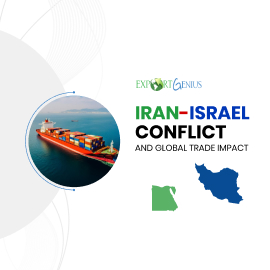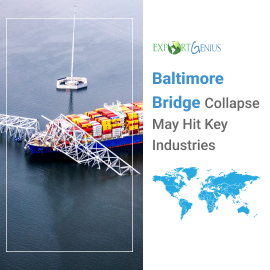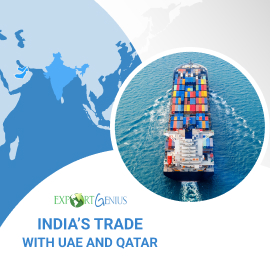India’s Exports and Imports May Hit from the Ongoing Red Sea Crisis
14 February 2024
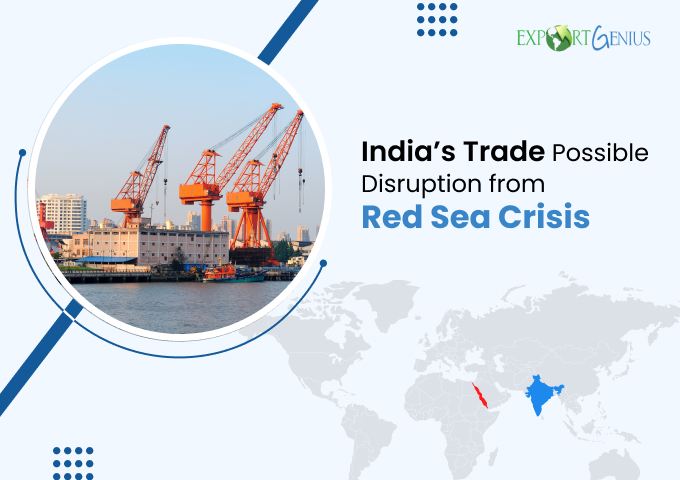
Main Highlights
Red Sea crisis impact on India’s trade which
accounts for 50% of the country’s exports and 30% of imports.
The demand for India’s basmati rice from the Middle
East, the United States and Europe is likely to hit.
Like basmati rice, chaos in the Red Sea is disrupting
shipments of other products as well including tea, spices, and buffalo meat.
Imports of fertilisers, sunflower oil,
machinery components and electronic goods are also likely to get disrupted from
the Red Sea attack.
India is facing an impact of the ongoing crisis around the Red Sea shipping route. The country is heavily reliant on the Red Sea route through the Suez Canal for its trade of goods with global regions, particularly Europe, North America, North Africa, and the Middle East. These regions accounted for about 50% of India’s exports and about 30% of imports. Let’s understand how Red Crisis may impact on India’s exports and imports of commodities.
Houthi rebels have been
carrying our missile and drone attacks on cargo ships in the Red Sea since
November, actions they say are in response to Israel’s war on Gaza. Retaliatory
strikes to aid the safe movement of ships by a US-led coalition have not stopped
the Houthi assaults.
Demand for India’s basmati
rice from the Middle East, the United States and Europe
Demand for India’s basmati,
the long-grain aromatic rice, from traditional buyers in the Middle East, and
the United States has dropped in October 2023, however that from Europe
increased slightly in the same month. Overall, India’s exports of basmati rice
to the world declined in September and October of 2023. The reason is the
escalating tensions in the Red Sea, the shortest and most efficient trade route
for ships moving from Asia to Europe.
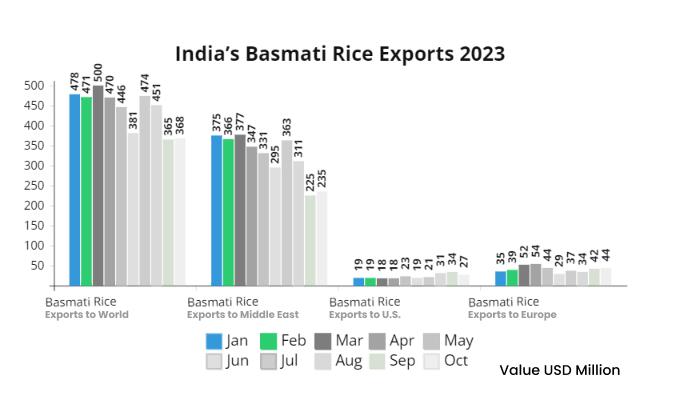
|
Month |
Basmati Rice Exports to World |
Basmati Rice Exports to Middle East |
Basmati Rice Exports to U.S. |
Basmati Rice Exports to Europe |
|
Jan |
478 |
375 |
19 |
35 |
|
Feb |
471 |
366 |
19 |
39 |
|
Mar |
500 |
377 |
18 |
52 |
|
Apr |
470 |
347 |
18 |
54 |
|
May |
446 |
331 |
23 |
44 |
|
Jun |
381 |
295 |
19 |
29 |
|
Jul |
474 |
363 |
21 |
37 |
|
Aug |
451 |
311 |
31 |
34 |
|
Sep |
365 |
225 |
34 |
42 |
|
Oct |
368 |
235 |
27 |
44 |
*******Value USD Million
India, the world’s biggest
rice exporter, ships more than 4.5 million tonnes of basmati rice to the world
annually. About 35% of about 7 million tonnes of production is exported to
Europe, North America, North Africa, and the Middle East through Red Sea.
Attacks by Iranian-backed
Houthis from Yemen on commercial vessels passing through the Red Sea have
forced shippers to avoid one of the world’s most crucial trade routes. The
alternative longer route around the Cape of Good Hope on the southern tip of
Africa has added more than 3,500 nautical miles (6,500 km) to the journey and
close to a half-month of sailing time to each trip, significantly increasing
shipping coasts.
Indian exporters of basmati
rice face challenges in shipping as freight costs have shot up as high as five
times with an increase in insurance premiums, shortage of containers and longer
transit time. According to a report, some companies have kept their inventories
at various ports or processing units and others have sold in the domestic
market, resulting in a fall in prices by about 8% in the local market.
India’s exports of other
commodities also hurt from Red Sea crisis
Like basmati rice, chaos in
the Red Sea is disrupting shipments of other products as well including tea,
spices, and buffalo meat. This has raised concern that the unrest will lead to
supply chain disruptions and contraction of trade, and halt a slowdown in food
inflation.
India’s buffalo meat export is
hurt from the Red Sea crisis. The country is one of the leading buffalo meat
exporters. About 60% of India’s shipments go through the Red Sea to North
African countries and Russia.
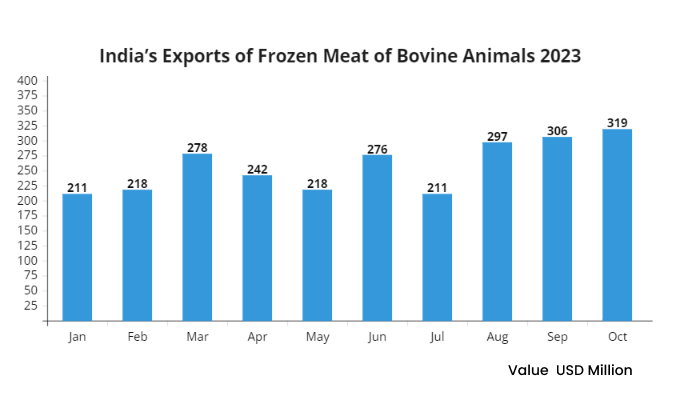
|
Month |
Value USD Million |
|
Jan |
211 |
|
Feb |
218 |
|
Mar |
278 |
|
Apr |
242 |
|
May |
218 |
|
Jun |
276 |
|
Jul |
211 |
|
Aug |
297 |
|
Sep |
306 |
|
Oct |
319 |
Similarly, marine items
including shrimps and prawns can also see a significant impact as around 80% of
the production is exported, and over half of it through the Red Sea. Their
perishable nature and lean margins make exporters vulnerable to increasing freight
costs and competitive pressure from Latin American suppliers.
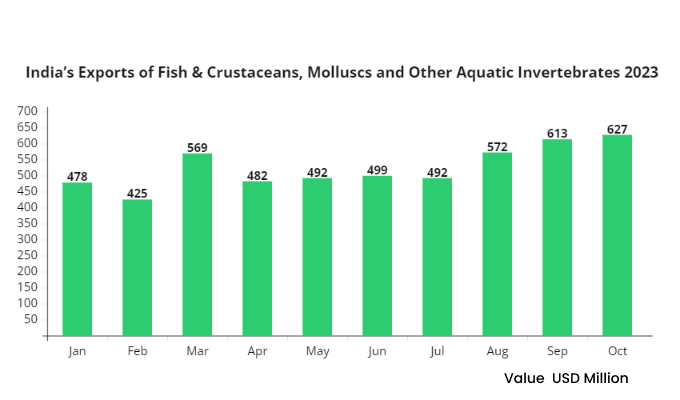
|
Month |
Value USD Million |
|
Jan |
478 |
|
Feb |
425 |
|
Mar |
569 |
|
Apr |
482 |
|
May |
492 |
|
Jun |
499 |
|
Jul |
492 |
|
Aug |
572 |
|
Sep |
613 |
|
Oct |
627 |
India’s imports also disrupted
due to Red Sea attack
Imports of fertilisers,
sunflower oil, machinery components and electronic goods are also likely to get
disrupted from the Red Sea attack. The supply of sunflower oil has become tight
for India, the world’s biggest importer of the vegetable oil. As most of the
vessels from Russia and Ukraine are being rerouted through the Cape of Good
Hope, freight costs have increased by 35% and transit time increased by 15
days. Similarly, shipments of fertilisers have been delayed and logistics costs
have risen.
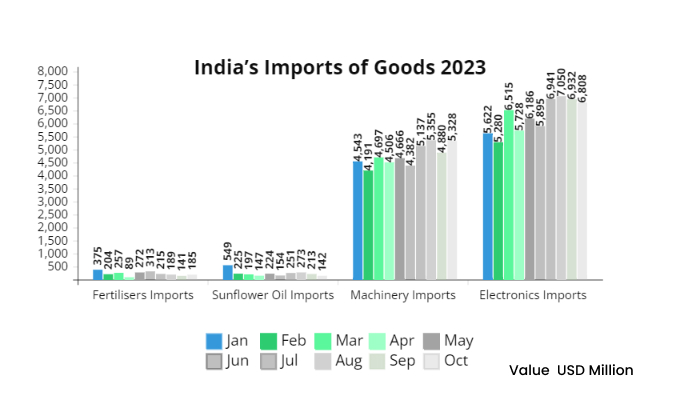
|
Month |
Fertilisers Imports |
Sunflower Oil Imports |
Machinery Imports |
Electronics Imports |
|
Jan |
375 |
549 |
4,543 |
5,622 |
|
Feb |
204 |
225 |
4,191 |
5,280 |
|
Mar |
257 |
197 |
4,697 |
6,515 |
|
Apr |
89 |
147 |
4,506 |
5,728 |
|
May |
272 |
224 |
4,666 |
6,186 |
|
Jun |
313 |
154 |
4,382 |
5,895 |
|
Jul |
215 |
251 |
5,137 |
6,941 |
|
Aug |
189 |
273 |
5,355 |
7,050 |
|
Sep |
141 |
213 |
4,880 |
6,932 |
|
Oct |
185 |
142 |
5,328 |
6,808 |
*****Value USD Million
However, there is no
disruption in oil flows even as the Red Sea is one of the key routes for oil
shipments for India which imports around 80% of its crude oil needs. Russia
emerged as one of the biggest crude oil suppliers to India in 2023, accounting
for more than one-third of its imports. According to a report, unlike other
sectors, there is no diversion of Russian vessels carrying crude oil bound for
India through the Red Sea.
Exports from Kolkata port, a
gateway to eastern India, are facing challenges including government’s rice
export ban, geopolitical tension, and skyrocketing ocean freight costs. As a
result, the trade activities are likely to get slow. Freight charges have gone
up since December last year due to the escalating conflict in the Red Sea,
forcing Indian exporters to halt their shipments.



